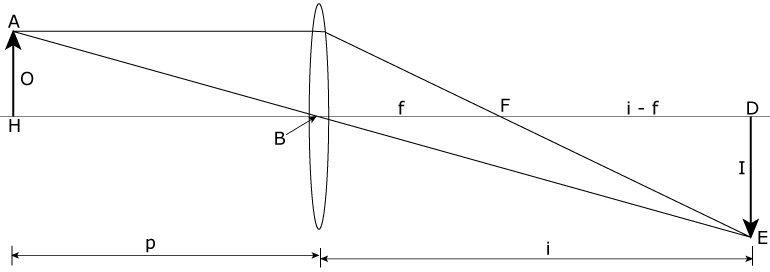- As a more dense medium is encountered, the wave is both slowed down and compressed. This means that the speed and the wavelengh will change, but the frequency will remain constant.
- In a vacuum the light travels at the "speed of light", c = 3 x 108 m/sec. The speed of the wave in a new medium, v, is related to the speed in a vacuum, c, by a constant called the index of refraction, n: c = nv, or n = c/v.
- The angle of refraction is the angle that the ray makes with the normal while in the second medium. The light goes through meduim #1 with index of refraction n1 toward the surface at an angle from the normal θ1 and then bends while in medium #2 which has an index of refraction n2 and an angle from the normal of θ2 (θ2 is the angle of refraction).
-
Snell's Law of Refraction relates medium #1 to medium #2:
n1sinθ1 = n2sinθ2
θc = sin-1(n2/n1)


- The object distance is always positive if the object is on the side of the lens or mirror from which the light is coming.
-
The image distance is positive:
- In the case of mirrors if the image is on the side of the mirror where the light is, i.e. in front of the mirror.
- In the case of lenses if the image is on the side of the lens to which the transmitted light goes.
- The focal length of converging mirrors and lenses is positive, while the focal length of diverging mirrors and lenses is negative.
- The object distance, p, is always positive, but the image distance, i, is negative for virtual images.
Examples
Snell's Law
A ray of light strikes a piece of glass (n = 1.5), making an angle of 50° with the surface (a) What angle does the refracted ray make with the srrface? (b) What is the speed of the light inside of the glass?
Assume that the index of refraction in air is the same as in a vacuum (n = 1) and remember that the angle of incidence is defined from the normal to the surface. In this case the angle of incidence would be 90° - 50° = 40°
(a) n1sinθ1 = n2sinθ2; θ2 = 25° and the angle with the surface is 65°
(b) v2 = (n1/n2)(v1) = (1/1.5)(3 x 108 m/sec) = 2 x 108 m/sec
The Lens Equation
-
An object 6 mm high is 12 cm to the left of a converging lens of focal length 4 cm. (a) Where is the image? (b) Is it real or virtual? (c) Is it erect or inverted? (d) How large is it?
(a) 1/12 + 1/i = 1/4; i = 6 cm to the right of the lens
(b) Because the image is on the opposite side of the lens from the object, the image is real.
(c) Real images are inverted.
(d) m = -i/p = -(6 cm)/(12 cm) = - 1/2; the size would be = (0.5)(6 mm) = 3 mm
-
Do the last problem for a diverging lens.
(a) 1/12 + 1/i = 1/(-4); i = -3 cm to the left of the lens
(b) Because the image is on the same side of the lens as the object, the image is virtual.
(c) Virtual images are erect.
(d) m = -i/p = -(-3 cm)/(12 cm) = 3/12 = 1/4 cm; the size would be = (1/4)(6 mm) = 3/2 mm